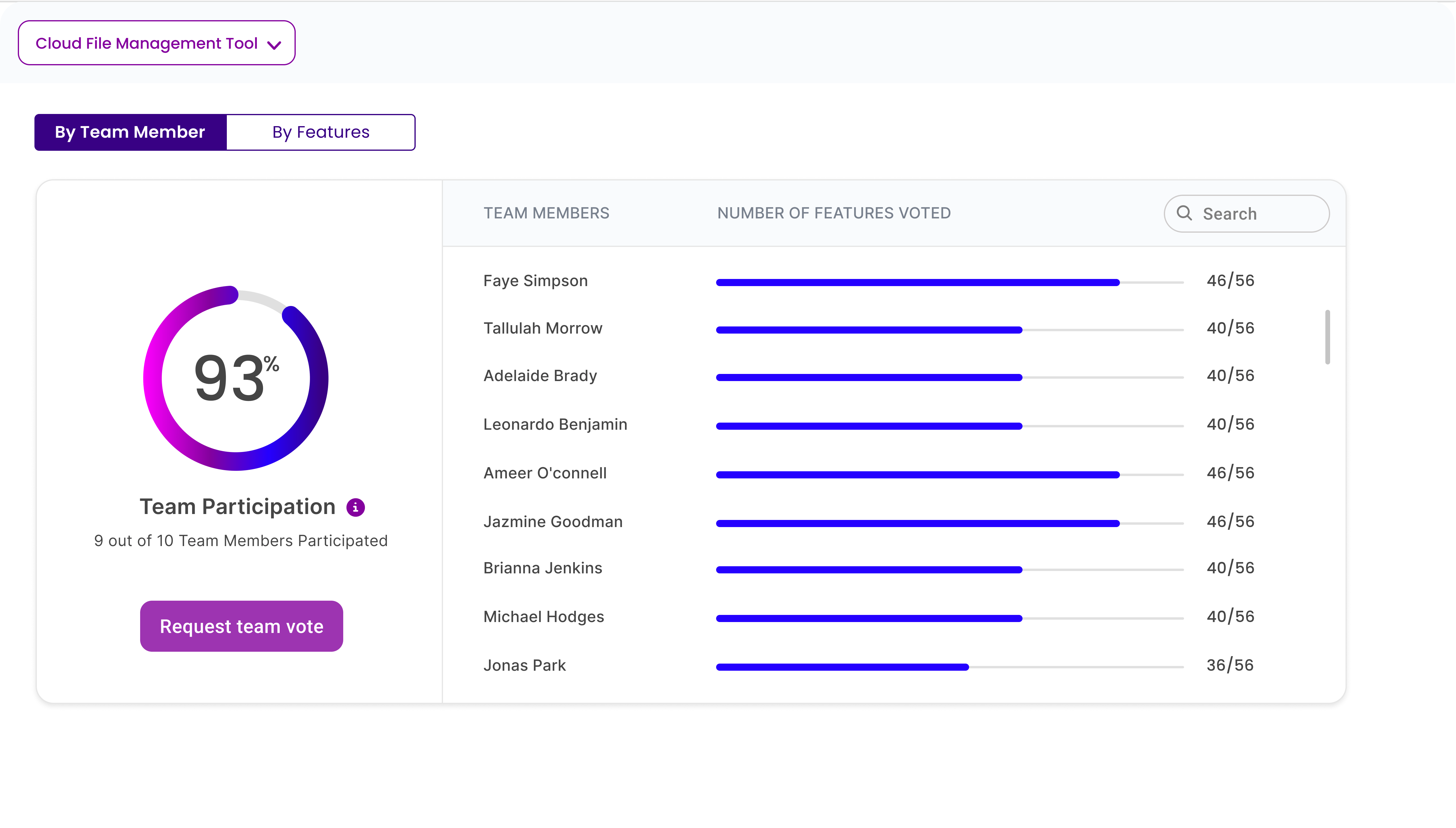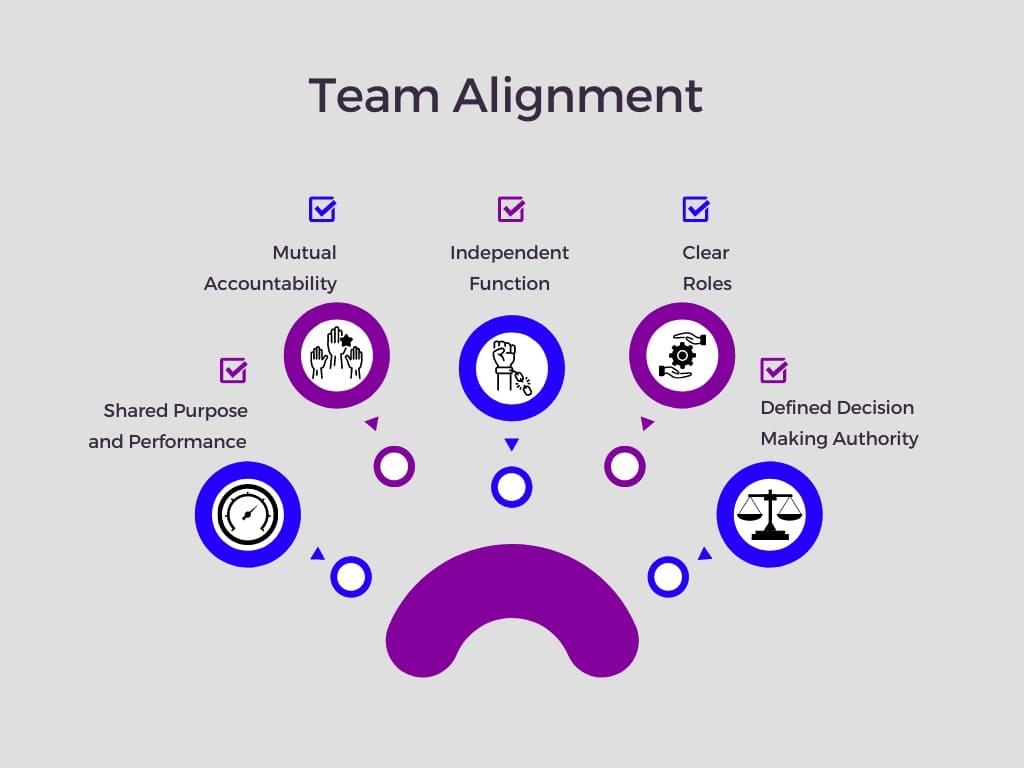What Is Team Alignment & Its Value to My Organization?

Kevin Rose wisely said, “A team aligned behind a vision will move mountains.”
Team alignment is the foundation of any high-performing organization. When a team is aligned with a shared vision, mission, and goals, they operate smoothly, efficiently, and effectively. Without alignment, even the most talented teams can experience friction, wasted effort, and suboptimal results.
Imagine investing time and resources into developing a meticulous strategy, only to see it crumble due to misalignment among your team members. Misaligned teams can lead to delays, misunderstandings, and subpar performance, ultimately hindering your organization’s ability to adapt, innovate, and thrive.
But there is good news. Studies have shown that employees who collaborate effectively are 64% more engaged than those who don’t. They also report lower fatigue levels and achieve higher success rates. Team alignment unlocks the potential for synergy, creating a work environment where individuals thrive, productivity soars, and organizational objectives are easily met.
In this article, we will explore the profound value of team alignment for your organization. We will uncover how it fosters innovation, enhances efficiency, and empowers your team to achieve their goals.
What Is Team Alignment?
Team alignment is arriving at a common understanding by which various employees across functions and departments communicate and collaborate to deliver specific organizational goals.
Team alignment includes technology and human process convergence around delivering better products and services to customers.
With Covid-19 and subsequent lockdowns that have pushed team members to remote working environments, team alignment has become even more critical.
Under on-premise working conditions, issues relating to lack of alignment tend to expose themselves faster as everyone is physically in the same workspace.
However, when team members work together but spread across remote locations, issues emerging from lack of alignment may remain hidden until a significant roadblock gets discovered.
Therefore, it is even more critical that managers align their teams using technology and processes. The goal is to cut losses from a lack of clarity around work delivery, timeframes, key objectives, targets, and goals.
Team alignment is often cross-team, where various disciplines come together to deliver a final project, product, or service.
Bonus: Want to learn how a cross-functional team works? Then, click here.
For example, suppose technology product managers work with programmers, engineers, digital designers, and marketers. Then, each member who belongs to other functional teams must be on the same page.
In addition, even members of the same functional group may need alignment.
For example, programmers and developers who are also part of a larger product development team will need alignment. It ensures that the same tech-stack, programming language, and development methodologies get implemented.
Signs Your Team Is Not Aligned
Detecting misalignment within an organization is crucial to rectify issues and steer it back on course. While various indicators may signal misalignment, these nine recurring signs warrant close attention:
Lack of Progress and Stagnation
One of the most prominent signs of misalignment is when a company experiences a lack of progress and remains stagnant. Despite ongoing efforts, there is no significant movement toward achieving organizational goals. This stagnation can demotivate employees and harm the company’s growth.
Unhappy Employees
Employee happiness is a critical indicator of a company’s health. When employees are consistently unhappy, it can be a clear sign of misalignment. Factors contributing to unhappiness may include job dissatisfaction, lack of recognition, or an unhealthy work environment.
High Employee Turnover
High turnover rates are a red flag for misalignment. If many employees are leaving the company, it’s essential to investigate the root causes. Misalignment can lead to frustration and dissatisfaction, driving talented individuals to seek opportunities elsewhere.
Low Employee Morale
Low morale among employees is often a result of misalignment. When employees feel disconnected from the company’s mission or undervalued, their morale plummets. It can manifest as decreased enthusiasm, motivation, and overall job satisfaction.
Lack of Clear Vision
An organization without a clear vision of where it wants to go in the future is susceptible to misalignment. Employees may struggle to work cohesively towards common goals without a shared sense of purpose and direction.
Communication Breakdown
Effective communication is the lifeblood of any organization. Misalignment often leads to a breakdown in communication between teams and departments. It can result in misunderstandings, duplication of efforts, and decreased productivity.
Unclear Goals
Employees need clear goals to work towards. When they don’t know what you expect of them or how their work contributes to the company’s success, it can lead to confusion and disengagement.
Lack of Support from Management
In an aligned organization, employees should feel supported by their managers. When misalignment occurs, employees may perceive a lack of support, especially when they need it most, or make mistakes on the job.
Suppressed Employee Voice
In a misaligned company, employees may feel they cannot be themselves at work or that their ideas don’t matter as much as others. It can stifle creativity and innovation, hindering the company’s ability to adapt and grow.
Recognizing and addressing these signs promptly is essential for realigning the organization, boosting employee engagement, and ensuring a clearer path toward success.
Why is Team Alignment important?
Team alignment is critical to ensure that every member understands the final goals, the approaches, and the strategies used to achieve them.
Furthermore, human talent management, type of methodology used, type of technology, and tools to acquire – require team alignment.

To better understand the importance of team alignment, let us look at the objectives met when your team is aligned.
Key Objectives of Team Alignment
Shared responsibility for the outcome
Output may be personal. The outcome, however, is almost ways a team alignment effort.
For example, writing an article is the writer’s output, editing is the editor’s output, and posting it is the site manager’s output.
However, when they are all aligned – the result is an article that generates traffic.
The more aligned they are, the better and faster the production of quality content.
Team leaders must ensure that team members align on their individual goals and collaborate to get a result that benefits the entire organization.

Reduced wastage of resources and increased exchange of knowledge
Unaligned teams are redundant processes, technology purchases (similar products used by different teams), and multiple copies of the same work.
In programming, for instance, a piece of code may have to be written for one project and may need to be written again for another project.
Through cross-team alignment, the team leads can identify redundant work by their members and exchange knowledge among their team members.
Promotes transparency and accountability
‘A millennial workforce today demands transparency above all else. A manager of millennials needs accountability.’
Early alignment is key to transparency among team members. In this case, each person knows what another is working on and how each member is accountable for a specific task for the final outcome.
Better ideation process
Ideas are no one’s monopoly.
There must be a time and place to share, debate, discuss, and then move forward on an agreed-upon set of ideas.
Team alignment and meetings allow individuals to share their unique perspectives and ideas, often coming together to form better working conditions.
Without a safe and structured space for team alignment, where people can speak freely within the confines of the scope, a discussion may be suppressed or lost.

Acts as a trust-building activity
Team members who understand each other are more tolerant and friendly to one another.
This understanding may stem from a technical, work-related discussion. Still, it leads to a personal bond that helps develop a healthier working environment.
It is especially true today when our workplaces, remote or on-premise, are filled with people from various backgrounds who are in different stages of their lives.
We highly recommend using software for product managers to build team alignment, create product roadmaps, and collect customer feedback.

How to Build Team Alignment in Your Organization
Team alignment is essential for any business that wants to succeed. When a team is aligned, everyone is working towards the same goals and objectives, and there is a clear understanding of how each individual’s role contributes to the team’s overall success. It leads to increased productivity, efficiency, and morale.
Here are some insights on how to create team alignment:
Step 1: Highlight How Each Skill Contributes to the Achievement of Goals
Establishing team cohesion begins with a solid foundation. Effective communication and a clear sense of direction are paramount. When dealing with teams, ensuring everyone is working towards a shared objective is crucial.
Ensuring each team member understands how their skills dovetail with the overarching goal and benefit their colleagues prevents anyone from feeling isolated. Companies have a purpose, and aligning the team ensures everyone is well-versed in that purpose.
Step 2: Promote Teamwork Outside of the Workplace
One method to foster team alignment is occasionally engaging the team in activities outside the workplace. While it may sound unconventional, organizing team-building activities that may not directly relate to work can help establish camaraderie and respect for team members in a non-professional setting.
It can complement the groundwork laid in the office environment, enabling a deeper understanding of each team member’s humanity and uncovering skills that may not be readily apparent in their day-to-day job tasks.
It allows business leaders to discover new talents among their employees, facilitates personal growth, and introduces innovative methods to maintain alignment with the team’s goals.
“Don’t treat this team building like daily activities. Team alignment improves when team members can get to know each other in ways beyond tasks. Creating space for personal connections builds rapport and opens communication channels, which directly combat turnover and disengagement risks,” said Geoff Whiting, Content Strategy Manager at Hubstaff.
Give your team a chance to share interests, plans, and support or encouragement. Managers should build this time into schedules, such as setting short introductions across departments. When leadership drives these initiatives, they build internal trust and establish camaraderie that may otherwise struggle in remote and hybrid settings.
You can even arrange a team-building hiking trip that can help your team grow stronger in the future. For most of us, interacting with the natural environment is an uncommon experience, and, while it does not require any specific training it can automatically teach your team more new things – to communicate and completely understand each other. You can organize such a trip yourself or order it with the help of a reputable trekking company and choose a destination that will be preferable for your team members.
Step 3: Continue to Follow-Up Frequently
Opting for an ongoing approach rather than a one-time event is advisable for achieving team alignment. Conducting a meeting and outlining weekly goals is a positive step. However, assuming that a single communication suffices for complete comprehension is a mistake. It is crucial to follow up consistently.
Check-in with team members to offer assistance and inquire if any changes have occurred that may impact priorities.
Taking the initiative to reach out regularly distinguishes between a team that merely functions and one that operates seamlessly. It ensures that everyone remains on course with the weekly common goals and demonstrates a genuine commitment to continuous and regular communication within the team.
Step 4: Establish a Growth Mindset
Embracing a growth mindset is a fundamental value in establishing team alignment. Every team member must recognize their significance and the valuable skills they bring. However, their role goes beyond their existing contributions.
They have the potential for ongoing growth, which can assist in challenging and evolving team objectives.
Continuous growth supports the implementation of fresh strategies, and a commitment to progress ensures that everyone on the team remains in true alignment. Consistent evaluation and pursuing higher standards are essential aspects of this approach.
Step 5: Determine Each Member’s Responsibility
Transparency regarding each team member’s responsibilities is key in fostering team alignment. When everyone is aware of their colleagues’ roles and accountabilities, it promotes trust and accountability within the team.
It also reduces duplication of efforts and prevents members from encroaching on each other’s responsibilities. This approach enables each team member to concentrate on their specific tasks and significantly impact the organization.
Step 6: Set Specific Goals
You can achieve team alignment by setting unambiguous and realistic objectives and expectations for the team. Knowing your destination is the first step in the journey. Defining these expectations and goals will align the team with shared objectives and targets.
Bonus tip: Keep lines of communication open.
Communication is essential for team alignment. Ensure your team members feel comfortable communicating with each other and with you. Encourage them to ask questions, share ideas, and raise concerns. You can also use Slack, Microsoft Teams, or Zoom to facilitate communication and collaboration.
Key Best Practices for Aligning Your Team in 2023
Company-wide alignment across basics – Product, Process, and Customer
The most preliminary alignment needed across teams, departments, products, and functions is the need for utmost clarity. It includes the company’s product suite, what problems they solve, and who buys them (target audience).
Whether an employee works in HR, engineering, marketing, accounting, or sales, this fundamental clarity and alignment on these core aspects play into every single role.
How effectively they produce quality work aligned to the company’s core objectives depends on what they sell, to whom, and why.
Provide individual targets
Company outcomes are collected and shared by every employee. However, the productive work of each employee comes together to create this common success.
For this reason, alignment around individual targets is key to ensuring that every employee knows how they contribute to the firm’s overall success.
It is also vital for their feeling of having a goal and the encouragement from accomplishing these individual goals.
Bonus: Click here to learn about setting quarterly goals that are practically achievable.
Showcase how individual targets converse
Following our previous point, aligning your team members to showcase how their work collectively aims and accomplishes revenue goals is critical.
It is not the same as revenue attribution for every individual’s target. In many cases, revenues cannot be accurately attributed, especially in engineering and marketing.
However, from a team and process perspective, it can be explained how each role and target contributes to the final outcome.
Invest in alignment technologies
Team alignment depends heavily on technology enablers, especially in today’s increasingly remote working environment.
For instance, while investing in project or product management tools, they should be vested in the level of team collaboration and alignment they can facilitate.
Unlike point solutions like Slack, unified product management suites provide collaboration tools that better sync with the day-to-day communication activities of managers and employees.
Alternatively, users can aim for remote collaboration point solutions like corporate instant messenger tools for live chat.
Discourage but don’t stop post-alignment meet queries
Team alignment is also an investment, apart from being an asset when used correctly.
It implies that there has to be a certain level of adherence to the alignment process by every team member, invariant of hierarchy. It includes ensuring that the time allocated to align team members, even if it gets segmented, should be adequately utilized.
You do this to get queries resolved and arrive at the same page.
A manager should not discourage querying on a subject they have already discussed, and the team is aligned.
However, it may be discouraged to ensure proper time utilization, primarily upon establishing the process.
